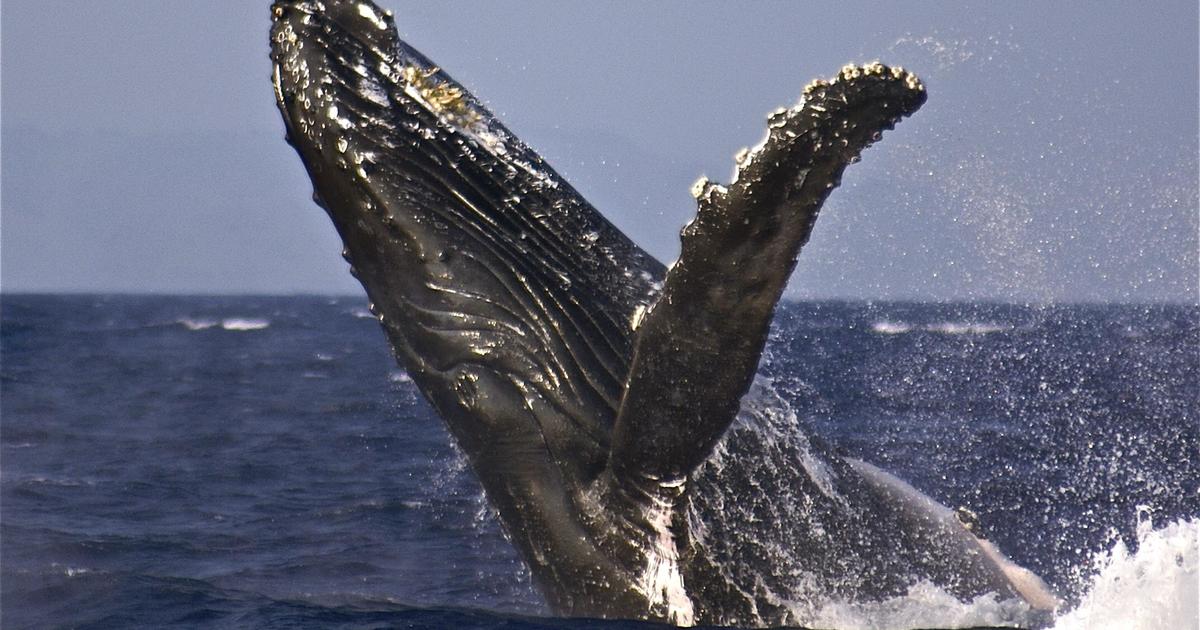CBS News
It took decades to recover humpback whale numbers in the North Pacific. Then a heat wave killed thousands.

The humpback whale population in the North Pacific was once reduced to just a few thousand individuals because of commercial whaling. It finally peaked at more than 33,000 whales in 2012 – and then came “The Blob.”
In 2013, a mass of warm water hit the region, creating an “ever-expanding hot spot” extending from the Gulf of Alaska to Baja California that spiked sea surface temperatures by as much as 7 degrees Fahrenheit on average, NOAA said. The event lasted four years and led to changes in salmon and sea turtle migration routes, as well as a record toxic algae outbreak that impacted crab fishing, seabird mortalities, whale entanglements and sea lion babies.
And now, a new study has found another devastating impact – the loss of humpback whales that conservationists had spent decades trying to recover.
Using artificial intelligence and thousands of photos of whales taken over a 20-year period, a new study published in Royal Society Open Science on Wednesday found that the mass of warm water contributed to the deaths of thousands of humpback whales in the North Pacific, roughly 20% of the population, between 2012 and 2021.
“The humpback whale population had recovered to a place that the ocean suddenly couldn’t support,” said Ted Cheeseman, a doctoral student at Australia’s Southern Cross University and lead author of the study. “About 7,000 whales died as that capacity declined.”
The study says that the humpback whale population significantly decreased in the North Pacific due to commercial whaling, and when that practice ended in 1976, it took 40 years for the species in the area to recover. The regional population went from around 17,000 members in 2002 to a peak of just under 34,500 members in 2012, with some smaller populations in the area recovering so well that they no longer needed protection under the Endangered Species Act.
Then by 2021, the population declined again, to about 26,600. That loss, the study says, “suggests the population abruptly reached carrying capacity due to loss of prey resources.” Essentially, the study says, more marine animals were competing for less available food, leading to “severely diminished presence of calces, prevalence of ‘skinny’ whales, increased strandings.” Fewer whales and calves were seen at breeding grounds during that time, as well.
The loss was most obvious in Hawaii, where humpbacks from the North Pacific will travel 3,000 miles in as little as 28 days to mate and give birth. There, the population declined by more than a third from its peak during that period. A separate study in 2022 found that humpbacks may stop making their yearly trek to the area as unprecedented levels of ocean warming could soon raise water temperatures in Hawaii beyond the point of comfort for the species.
Cheeseman said his team expected to see an impact from the event on the species, but they weren’t anticipating finding impacts from climate change as a whole.
NOAA/NCEI World Ocean Database
NOAA has previously said that the “impacts of climate change on whales are unknown, but it is considered one of the largest threats” to those that live in higher latitudes. Vessel strikes and entanglements are also major threats.
“Any resulting changes in prey distribution could lead to changes in foraging behavior, nutritional stress, and diminished reproduction for humpback whales,” NOAA says. “Additionally, changing water temperature and currents could impact the timing of environmental cues important for navigation and migration.”
Roughly 90% of the warming the planet is experiencing – mostly from the continued burning of fossil fuels – occurs in the ocean. Both the warming in the air and the water contribute to the loss of sea ice, rising sea levels, extreme weather conditions and changes in ecosystems, all of which perpetuate the cycle of rising temperatures and changing environments as we know them.
It also makes events like “The Blob” all the more possible.
“We know that marine heat waves all over the planet are becoming warmer over time,” NOAA said after last year’s marine heat wave off of Florida. “…Extreme heat can be destructive and deadly for marine systems.”
Cheeseman doesn’t think climate change itself will cause humpback whales to nearly go extinct as commercial whaling did, but it will have a significant impact.
“We are at risk of less productive oceans because of climate change,” he said, “and that is our doing as well.”
CBS News
Could prison companies get a boost from Trump’s immigration policies?

The Trump administration could be a boon for business for private prison companies in the U.S. if the president-elect delivers on his promise to crack down on illegal immigration.
CoreCivic and Geo Group, the two biggest private prison operators in the U.S., both contract with the U.S. Immigration and Customs Enforcement (ICE) to house detained, undocumented migrants. Their stocks soared Wednesday following Trump’s election win, with investors betting the companies will see increased profits from a tough-on-immigration administration.
CoreCivic, which closed at $13.50 a share on November 5, is trading at $22 a share, while Geo Group, which closed at $15 a share Tuesday, is currently trading at $23.75.
“Obviously, investors believe there is going to be a significant increase in opportunity for both of these firms under the Trump administration,” Noble Capital Markets analyst Joe Gomes told CBS MoneyWatch.
Geo Group executives acknowledged on the company’s third-quarter earnings call Thursday that it expects the incoming administration to enact stricter border security policies and that the company stands “ready to provide additional resources to help ICE meet future needs.”
CoreCivic executives also said they believe the election result will drive demand for its services.
ICE is biggest customer
During Trump’s first term in office, from 2017-2021, immigration detention expanded at record levels, according to an ACLU report. In 2019, ICE detained an average of over 50,000 people each day. At times, that number exceeded 56,000 — about 50% more than peak levels during the Obama administration, according to the report. During his first term in office, Trump expanded the federal government’s use of private prison companies to detain immigrants.
As of January 2020, 81% of people detained in ICE custody across the U.S. were held in facilities owned or managed by private prison corporations, according to the ACLU report.
In his second term, President-elect Trump promises a radical shift in policy at the U.S.-Mexico border from his predecessor. That includes a pledge to oversee the largest deportation operation in American history, which could bring significantly more business to CoreCivic and Geo Group.
For the first nine months of 2024, ICE accounted for 30% of each company’s revenue.
Both Geo Group and CoreCivic said they currently have excess capacity to accommodate a larger population of detainees. CoreCivic executives noted that they’re taking steps to prepare to activate additional capacity to meet ICE’s needs. That could include reconfiguring facilities to accommodate a bigger intake area, they noted.
“There is room for an uptick in occupancy from a capacity standpoint and both companies expect an ask from the Trump administration for more beds. The question is how much, and we just don’t know right now,” Wedbush Securities analyst Brian Violino told CBS MoneyWatch.
Monitoring
Geo Group also provides monitoring services for ICE under its Intensive Supervision Appearance Program (ISAP), a monitoring program using wearable technology that serves as an alternative to detention.
“If there is a finite number of beds and a significant number of people are detained, which Trump is discussing in his plans, there could be an increased usage in this alternative to detention,” Violino said.
Geo Group executives said they have the necessary technology and staffing resources to scale up the contract to more than several million participants, if necessary.
Funding from Congress
The degree to which ICE expands its contracts with the two largest private prison companies depends on how big of an increase in funding Congress authorizes. While Republicans won the Senate majority in Tuesday’s election, it remains to be seen which party will obtain control of the U.S. House of Representatives.
“That’s a big part of the story, and if it’s a Republican sweep, it will be easier for Trump to get funding from Congress to support this operation he’s looking to do,” Violino said.
CBS News
What’s next for Harris, Trump after the 2024 elections

Watch CBS News
Be the first to know
Get browser notifications for breaking news, live events, and exclusive reporting.
CBS News
How the Federal Reserve interest rate cut could affect Americans

Watch CBS News
Be the first to know
Get browser notifications for breaking news, live events, and exclusive reporting.










